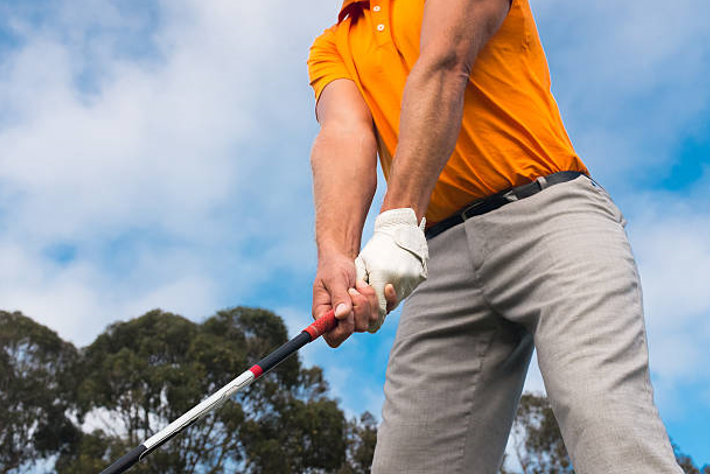The grip of the golf club is one of the most important decisions made by amateur golfers. There are three types of grips one uses. There are three ways to hold a club – the overlapping grip also known as the Vardon grip or the Vardon overlap, interlocking grip, and the ten-finger grip also known as the baseball grip. The overlapping grip places the club in the fingers. The little finger is placed between the index and middle finger on the lead hand. The interlocking grip is the most common. We interlock the little finger of the trailing hand with the index finger of the lead hand. While this grip locks the hands together, there is a risk of the handle straying into the palms of the player. The ten-finger grip is used mainly in the initial teaching days of golf. It is also used by people with joint pains or arthritis. In this grip, one places the lead hand first and then places the little finger of the trailing hand as close to the index finger of the lead hand as possible.
The grip refers to the direction in which your hands are placed on the club. It helps us control the direction and swing of our ball. It could end up determining whether your ball would end up in the woods or the middle of the fairway. In this article, we will look at strong, weak, and neutral grips and how each affects our game.
Strong Grip
In a strong grip, the ‘V’ shape made by the thumb and index finger points towards the right side of the head. In this grip, both the hands rotate away from the target and the club’s face is closed on impact. It should be used by someone who swings over the top or struggles with slicing the ball. Strong grips promote an in-to-out swing and make shots that spin right to the left easier to hit. Golf Magazine’s “The Best Driving Instruction Book Ever” recommends this grip for amateurs with fast hips. Practicing a strong grip can help you train to not flip the club at the ball. The more the left hand is on top and the right is under the club, the stronger the grip is.
Weak Grip
In a weak grip, the ‘V’ shape made by your thumb and the index finger is pointed towards the left side of your head. In this grip, both the hands rotate towards the target and promote an out-to-in swing with an open clubface on impact. It helps players who struggle with hooked shots and can help neutralize a swing if it is shot too much from the inside. It produces a natural fade and is recommended by Golf Magazine for people with slow hips. Using a weak grip with slow hips reduces the tendency to pull or hook the ball. This grip requires a lot of added rotation in the hands and wrists as well. One must also be pretty careful of their timings and aggression. In this grip, the left grip sits under the golf grip and the right hand is more on top.

Neutral Grip
In a neutral grip, the ‘V’ shape formed by the thumb and the index finger is pointed upwards towards the nose. This grip is ideal for players who hit the ball in a fairly straight direction. Players who have sound swing mechanics and do not struggle with losing shots in different directions should use this grip. It helps the players to ‘shape the ball’ and is recommended for players with medium hip speed by Golf Magazine. One can even say that this is the grip used by seasoned players.
A grip can change the direction, height and speed of your shot. One must identify their weak points and areas where they struggle to be able to fix them by altering their grips. Finding the perfect grip is like trying to hold a bird in your hands. One must hold it tight enough to not let it fly away and loose enough as to not suffocate it. It is important to make sure that the clubface is facing your target. Finding the right balance for your grip could make a huge difference to your game. It might take a little trial and error to find the best grip for you, but it will be worth the struggle.

